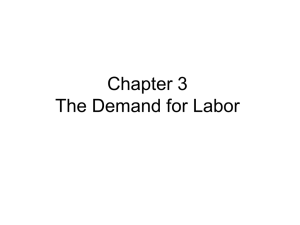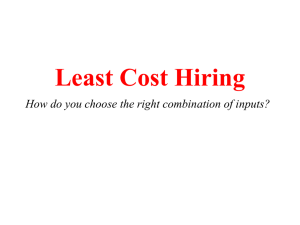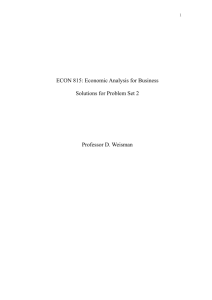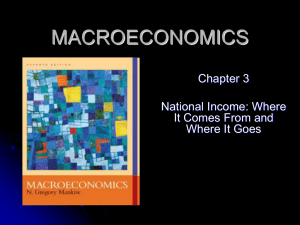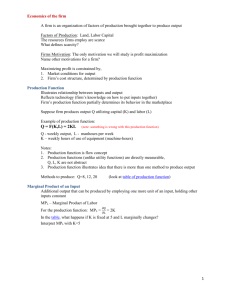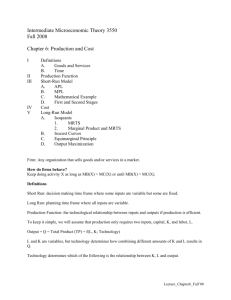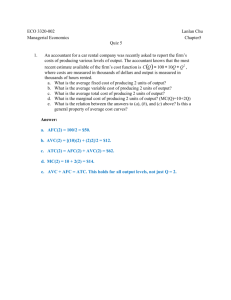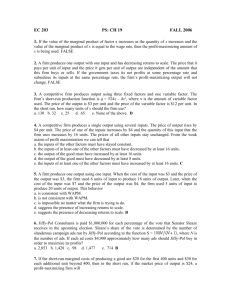Production and Costs
advertisement
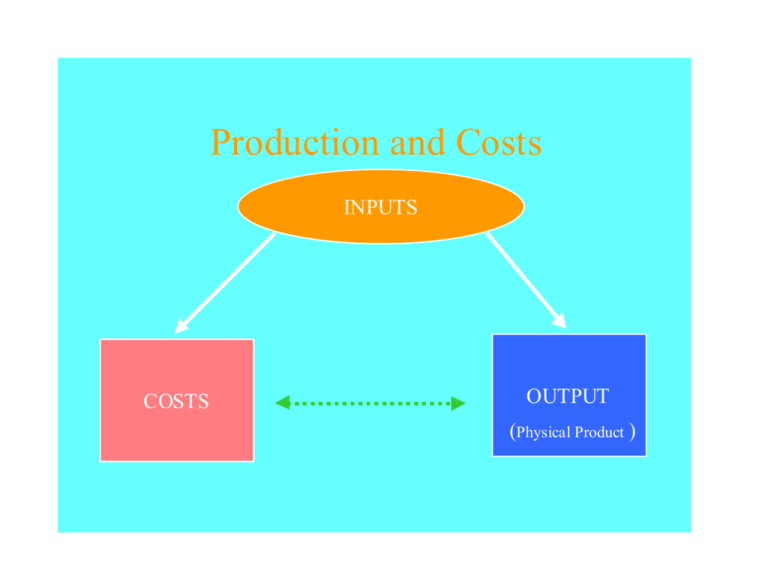
Production and Costs INPUTS COSTS OUTPUT (Physical Product ) Inputs: Factors of Production Factors of production: • Land Labor Capital • Intermediate goods • (Entrepreneurial Services ) • Production Costs = Costs of Inputs Production in the Short Run versus Production in the Long Run • In the short run at least one of the factors of production remains unchanged (fixed). • In the long run all factors of production are variable. • In a two-input production process, in the short run, only one input is variable. • In a two-input production model, in the short run, the changes in the output (physical product) are the result of changes in the variable input. Production in the Long Run • In the long run all inputs used in the production process by the firm are variable. • In a two-input production model, in the long run, both inputs (say, capital and labor) are variable. • In the long run the level of the output of a firm can change as a result of changes in any or all inputs. A Short-Run Production (Function) Analysis Our model: A firm using two inputs: Capital (K); Fixed Input Labor (L); Variable input We examine the relationship between the variable input (labor) and the output. We examine how changes in labor (the variable input) affect the out put. Output Measures • Total (Physical) Product (output), TPP: The total amount of output produced by the firm over a certain period • Average (Physical) Product (of the variable input), APP: Total (Physical) Product divided by the number units of the variable input • Marginal (Physical) Product (of the variable input), MPP: The change in total product resulting from employing one additional unit of the variable input Production in the Short Run Inputs: Capital (K) and Labor (L) K = 20 (Fixed) Labor: Variable Total Marginal P. Product Labor (L) P. Product 0 0 1 10 10 2 25 15 3 35 10 4 44 9 5 51 7 6 56 5 7 60 4 8 62 2 9 62 0 Average P. Product 10.0 12.5 11.7 11.0 10.2 9.3 8.6 7.8 6.9 Total (Physical) Product and Marginal Physical Product Marginal Product T ot al P r oduct 16 14 70 60 12 50 10 40 8 30 6 20 4 10 2 0 0 0 5 10 0 2 4 6 8 10 Average (Physical) Product and Marginal Physical Product Average Product 20 14 12 10 8 6 4 2 0 15 10 5 AP MP 0 0 5 10 1 2 3 4 5 6 7 8 9 10 MPP and APP Change in TPP Marginal Physical Product = MPP = Change in V. Input Total Physical Product Average Physical Product = APP = Total V. Input The “Law” of Diminishing Return • Increases in the amount of any one input, holding the amounts all other inputs constant, would eventually result in decreasing marginal product of the variable input. Explanation: Unless all inputs are perfectly and infinitely substitutable, as we increase the amount of one input, while keeping other inputs constant, at some point the productive effectiveness of that input starts to decline. Long-Run Production Function Capital => Labor || V 1 2 3 4 5 0 1 2 3 4 3 5 6 6 5 10 18 23 25 26 15 30 40 45 47 18 40 47 52 56 20 46 52 60 65 Choosing the Optimal Mix of Inputs • One approach to choosing the optimal (least costly) mix of inputs is to compare the (marginal) cost of producing one extra unit of out put across different inputs. • The firm would likely use the input that increases its output at the lowest cost by comparing Input Price across all available inputs. MPP Capital Labor 10 15 20 25 30 35 40 50 7.36 5.62 4.64 4 3.54 3.19 2.925 2.52 Isoquant and Isocost Q = f ( K, L) Cost = rK + w L where r = price of capital w = wage Isoquant K Slope = MPL/MPK = MRTS Q4 Q3 Q2 Q1 0 L Isocost K Cost = r.K +w. L Cost/r Slope = w/r L 0 Cost/w Isocost K Cost = r.K +w. L Cost/r Slope = w/r Q2 Q1 L 0 Cost/w Input Optimizing Rule MPL MPK MPM --------- = --------- = --------- w or, r PM MPL w MPL w ------ = -------- , ---------- = --------MPM r MPM PM X path K Cost/r Q2 Q1 L 0 Cost/w $TC LTC Q o $ LTC LAC = LTC/Q LMC LMC = dLTC/dQ LAC LMC LAC= LMC MC Q $ LMC LAC Q o Q1 Q* Inputs: Capital (K) andLabor (L) CapPrice = K= 20 Lab: Variable Wage = Total T.Fixed T. Var Total Average Average Average Labor (L) Product Cost Cost Cost F.Cost V.Cost T.cost 0 0 40 0 40 1 10 40 6 46 4.00 0.60 4.60 2 25 40 12 52 1.60 0.48 2.08 3 35 40 18 58 1.14 0.51 1.66 4 44 40 24 64 0.91 0.55 1.45 5 51 40 30 70 0.78 0.59 1.37 6 56 40 36 76 0.71 0.64 1.36 7 60 40 42 82 0.67 0.70 1.37 8 62 40 48 88 0.65 0.77 1.42 9 62 40 54 94 0.65 0.87 1.52 2 6 Marginal Cost 0.60 0.40 0.60 0.67 0.86 1.20 1.50 3.00 Plotting the Cost Measures 5 10 0 4. 5 90 4 80 3. 5 70 3 TC 60 MC 2. 5 50 2 40 TVC TFC 30 1 .5 AT C 20 1 AVC 0. 5 10 0 0 0 20 40 60 80 0 20 40 60 80 Plotting the Cost Measures 5 $ $ 4 .5 MC 4 ATC 3 .5 MC 3 2 .5 AVC 2 1 .5 AT C 1 AVC 0 .5 A FC AFC 0 0 20 40 60 Q 80 o Q Long-Run Average Total Cost (LATC) K = 10 Wage= L TPP TC 0 20 1 12 25 2 25 30 3 37 35 4 47 40 5 55 45 6 61 50 7 65 55 8 68 60 9 69 65 10 69 70 5 K= ATC L 0 2.08 1 1.20 2 0.95 3 0.85 4 0.82 5 0.82 6 0.85 7 0.88 8 0.94 9 1.01 10 20 TPP TC 40 20 45 45 50 70 55 90 60 108 65 127 70 141 75 149 80 155 85 157 90 ATC 2.25 1.11 0.79 0.67 0.60 0.55 0.53 0.54 0.55 0.57 K= L 0 1 2 3 4 5 6 7 8 9 10 30 TPP TC 60 28 65 60 70 90 75 118 80 143 85 164 90 183 95 195 100 202 105 204 110 ATC 2.32 1.17 0.83 0.68 0.59 0.55 0.52 0.51 0.52 0.54 Long-Run Average Total Cost ATC ATC ATC 2. 5 2.5 2.5 2 2 2 1. 5 1.5 1.5 1 1 1 0. 5 0.5 0.5 0 0 0 0 50 100 K=30 K=20 K=1 0 0 50 100 150 200 0 100 200 300 LATC K= 10 L= 6 .82 K= 20 L= 7 .53 .51 K= 30 L=8 LATC Q o 61 141 195 Long-Run Average Total Cost $ (SATC)1 (SATC)2 (SATC)3 LATC 0 Q Return to Scale $ Constant Return to Scale LATC Increasing Return to Scale 0 Decreasing Return to Scale Q Return to Scale • Output elasticity: εQ % Change in Output %Change in all inputs ε >1 Constant Return: ε = 1 Diminishing Return: ε < 1 Cobb-Douglas function: Q = a Kb1Lb2 Increasing Return: Q Q Q b1+ b2 >1 b1 + b2 = 1 b1 + b2 < 1 Input Optimization Revisited Marginal revenue product of an input is the value of the output produced from applying one additional unit of that input: MRPL = MPL .Price of output = MPL. MR MRPK = MPK.Price of output = MPK. MR Input-optimizing rule: A firm will hire/buy each input to the point where the marginal revenue product the input is equal to its price. MRPL = MPL. MR = w MRPK = MPK . MR= r Input optimization and demand for input: Wage 6.00 4.30 3.10 DL: MRPL=MPL.MR 2.00 o 10 22 45 90 L Another look at optimization rule: MPL . MR = MRPL= w MPL/MPK = MRTS = w/r MPK . MR = MRPK = r Alternatively: MPL. MR = w MPL MPL MR = MC
